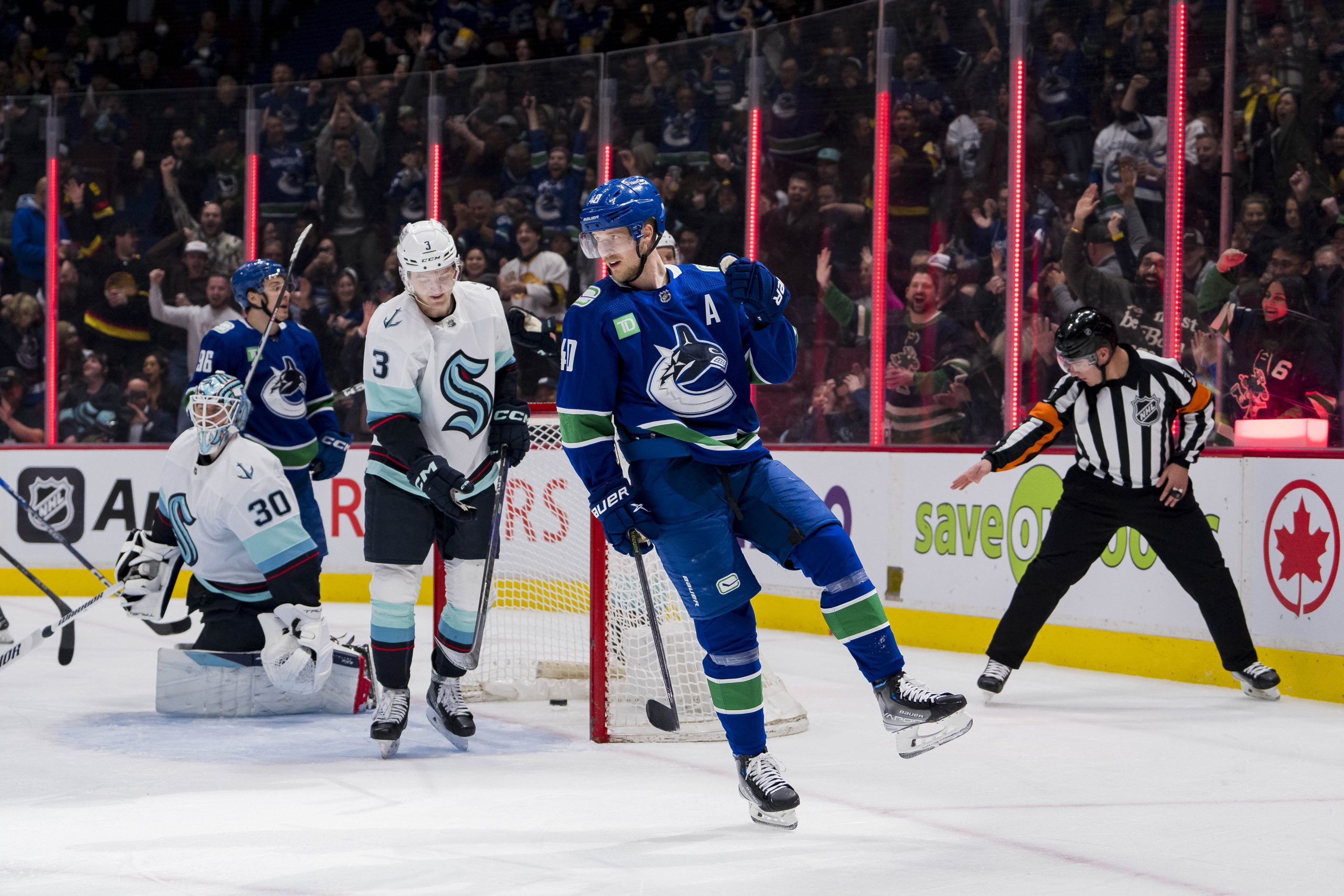The next Elias Pettersson contract will rival the biggest deals in Vancouver Canucks history. Unfortunately, we have no idea what it’s going to look like.
Elias Pettersson – not Incomparable, But Close
Despite entering the 2023-24 season with no free agents, the Vancouver Canucks have one big deal to work out between now and next July. As always, the first thing managers, agents, and fans do is look for numbers. Who’s close? Who signed? Are they worth it?
It’s understandable but misses a lot of the point. Each player, team, and circumstance is unique and will have their own priorities. Is the player willing to reduce their own paycheque to bring in talent, for instance?
That’s a favourite of team management in every professional league, everywhere. It’s a trick question, of course. The real question is: do you trust them to get it right with money that could have gone to you?
We’re going to take a look at three options that will crop up during negotiations: short, medium, and long. Each can benefit the player and the team in different ways, so we’ll find reasons why they’d agree.
The Long-Term Deal
Max it out, baby! The two sides sit down, decide this is where Pettersson wants to be, and BAM! He’s locked up for the maximum duration, eight years starting from 2024-25 through 2031-32.
For Comparison: David Pastrňák signed an eight-year, $ 11.25 million/annum deal. He’s about a year and a half older, with a much stronger scoring record. Pastrňák’s slightly older, exiting the deal when he’s 35, and plays on the wing, which is a less valuable position.
Pettersson’s scoring and defensive numbers are below Pastrňák’s, but he’s also been playing for the Canucks, not the Bruins. And as of Patrice Bergeron‘s and David Krejčí‘s retirements, Pastrňák is by far the most important skater in Boston.
The Deal: Given Pettersson’s age, position, and importance to the team, this could be a starting point. But with worse overall numbers on offence and defence, the deal should be close. Say $11.5 x eight years.
Why This Elias Pettersson Contract
The team says yes because of the length of the contract. Odds are that this isn’t the peak year of Pettersson’s career, both because of an improving team and improving player. He’s often talked about being a “more complete” player and working on his defence.
This is not the guy to bet against when he puts his mind to something.
Vancouver will feel the pinch of the Oliver Ekman-Larsson buyout in two seasons. Not re-negotiating a deal with your best forward right then is for the best. The Canucks are sure to be pitching maximum term as their first, second, and third offers. And probably more.
Pettersson says yes because it’s $92 million in his pocket, first off. Beyond that, he isn’t negotiating a new contract every few seasons in a hockey-mad market. Speculation about his third deal started the instant his current deal was signed. That has to be annoying.
And discussion of his second contract was a distraction throughout 2020-21. Not repeating that year any time soon would be a blessing. And there’s always the far-off thought that maybe, just maybe, last season WAS his best.
The odds of that are remote, true. But injury is always a possibility, and everyone needs to retire sometime. That’s one heck of a nest egg skate off the ice with, however many years from now.
Going Midsize
Okay, take it easy, now. Why lock yourself to a deal that might become an anchor? A more cautious approach – if not one the team will turn cartwheels over – is three or four seasons. Times change, and sometimes it changes quickly.
For Comparison: Jason Robertson‘s four-year deal is just slightly out of date, but it’s not an unreasonable place to start. The 24-year-old winger didn’t have the track record that Pettersson does now, of course. It’s even more remarkable.
Robertson scored 41 goals in just his second full NHL season. He was all of 22 years old, and still got a bridge deal instead of one long-term. Given that he followed his “breakout year” – if we can call it that – with 46 goals and 109 points, that’s looking good for him.
Unlike Robertson, Pettersson has another year to go on his current deal. He’s also a bit older and didn’t jump out to eye-popping numbers as early as Robertson. But he also has the confidence to bet on himself for the deal yet to come.
The Deal: If Pettersson wants fewer years, the Canucks will offer less money. The excuse will be that they need to improve quickly, and that’s going to cost in money and cap space. We’ll pretend Robertson’s first year doesn’t exist and bump it a little: three years, $9 million per.
Why This Elias Pettersson Contract
The team says yes because if they can get a 100-point player for three years they’ll take it. Yes, they will be under pressure to show they can compete within three years, but aren’t they always?
For their contract with J.T. Miller to make sense, they need to get him before old age does. Having the best of Miller, Pettersson, Thatcher Demko, and Quinn Hughes means figuring out the rest of the team as soon as possible. A three-year plan is already underway.
Pettersson’s coming off his three-year bridge deal next year. If he duplicates last season’s 39-goal, 102-point year then he’s set himself up for a big, big number. And unlike Robertson, he’ll bring a repeated triple-digit season to the bargaining table with him.
Pettersson says yes because he is an unrestricted free agent as of 2026-27. He will have seen the turnover from last season continue, draft prospects come up or not, and where the team is going. If he likes it, he can re-sign for much longer, and much more.
Should he not like what he sees from the team, he can always walk away. Especially if his numbers remain as high as expected. That may mean he gets traded away in his final year, but so be it. If he can pick his destination, he’d rather do it young.
Subcompact Contract
It wasn’t supposed to be this way. It wasn’t supposed to end like this. Not like this. But negotiations collapsed, the year was awful for all concerned, and it’s just plain ugly. Injury, underperformance, something happened here. So now what?
For Comparison: Really, the only way this happens is if the team and player are going to arbitration. But that doesn’t mean it can’t work.
The Deal: The qualifying offer is a paltry $8.82 million. That’s what the team will offer if Pettersson doesn’t manage at least 40 games due to injury. If it’s the other side, and Pettersson’s reluctance, expect the number to rocket upwards. His one season costs $10.75 million.
Why This Elias Pettersson Contract
In short, they had to. The team and the player agreed to terms either through arbitration or Pettersson agreeing to the team’s qualifying offer. In a worst-case scenario, Pettersson sustained a possible long-term injury. The “best” means he lost all confidence in the management group.
But not all is lost, even here. In signing a one-year contract, both sides have a chance to show the other what they can do. It’s the ultimate Show-Me deal, with the team auditioning for the player as much as any training camp invite.
Neither side wants this, but the silver lining reflects both ways. They could somehow find a resolution – even Sidney Crosby had career-threatening injury trouble – and then a long-term deal can be found.
Or Pettersson could do what Bo Horvat managed in his difficult year: score 30 goals in 50 games and get moved by the team. If there was ever a sign, unambiguous and flashing, for the Canucks to start a true rebuild, that would be it.
And if the Canucks can’t get a long-term Elias Pettersson contract done, what other choice will there be?
Main Photo: Bob Frid-USA TODAY Sports






